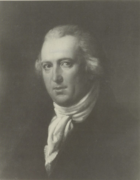Johann Baptist Wanhal and the First Viennese School
Paul Sommerfeld
Thursday, July 11, 2019

The following post originally appeared on the “In the Muse” blog from the Library of Congress and is by Paul Sommerfeld, who is currently updating the holdings of his library’s rich collection of printed music in RISM.
The mention of late-eighteenth century Vienna frequently conjures thoughts of well-known composers like Mozart, Haydn, and Beethoven. But since I joined a project reporting pre-1800 imprints and manuscripts to RISM (Répertoire International des Sources Musicales, an open-access database that lets you see which libraries have a certain published score or unique manuscript), I would like to add a fourth name to that list: Johann Baptist Wanhal (1739-1813).
In celebration of Wanhal’s 280th birthday on May 12th, I wanted to share his impressive music and interesting career, in addition to the Music Division’s ongoing efforts to make our pre-1800 musical scores more accessible.
A Bohemian composer, violinist, and teacher, Wanhal remained active in Austria throughout his life; he moved to Vienna in the early 1760s. Although some readers may recognize Wanhal’s name under the spelling Jan Křtitel Vaňhal, Wanhal himself used the “W” spelling, as did his Viennese contemporaries. The newer spelling came about in the 20th century as a modern Czech form following World War II.
Wanhal’s contemporaries attested to his position as one of the leading composers of his time. The influential writer Charles Burney wrote that several of Wanhal’s compositions, “particularly his symphonies, had afforded me such uncommon pleasure that I should not hesitate to rank them among the most complete and perfect compositions, for many instruments, which the art of music can boast.” Burney later wrote that Wanhal’s “spirited, natural, and unaffected symphonies” preceded those of Haydn, at least in England.” [1] Indeed, we do know that in 1784 Wanhal even played in a quartet—perhaps on the cello—with Haydn, the composer Carl Ditters von Dittersdorf, and Mozart himself.
Why do we not list Wanhal’s name in the same breath as the canonic Haydn, Mozart, and Beethoven? The answer is not that Wanhal’s music isn’t as good. Rather, the answer lies in how individuals in the past have chosen to champion one composer over another, and how we perpetuate that formation of the canon in the present. But I digress from the topic at hand.
Other scholars hear affinity to Mozart and early Beethoven in Wanhal’s music, but I view Wanhal’s career choices as equally interesting. Unlike Haydn, Wanhal spent most of his career working as an independent composer. He spent the last thirty years of his life with no consistent aristocratic benefactor—one of, if not the first, Viennese composers to do so. Responding to the Viennese public’s changing tastes in the late 1770s, Wanhal stopped composing the symphonies Burney so richly praised. Instead, he focused on music for piano, small chamber ensembles, and church music. He tailored this music to middle-class audiences, whose sales supplied him the means with which to live a modest, but economically independent life.
Wanhal’s choices in compositional choices in genre cultivated unique opportunities for him to influence the burgeoning Viennese music publishing industry. In the years that followed, Viennese publishers issued over 270 prints of Wanhal’s music. Foreign publishers such as André, the Hummels, John Bland, and Robert Bremner helped spread his music’s reach, providing a model for the composers who followed him in the nineteenth century.
Publications like Wanhal’s are what guide the Music Division’s ongoing project to let scholars, performers, and the public know what pre-1800 imprints and manuscript scores the Music Division has. For the past few months, I’ve been targeting composers under the letter “W,” which is how I happened upon Wanhal. In checking our card catalog (as we still need card catalogs to do some of our work) against musical scores listed in RISM, I found over 50 Wanhal published scores from the late 1700s in the Music Division’s collection that had gone unreported. My colleague Susan Clermont (whose name you may recognize from her recent post about baseball music) and I have been reporting these and many other scores to make them more accessible.
The images in this blog post all come from scores recently reported to RISM. Only time will tell what further treasures await acknowledgement in the present. In the meantime, you can search for more pre-1800 scores in our Online Catalog.
[1] Paul Bryan, Johann Wanhal, Viennese Symphonist: His Life and His Musical Environment (Stuyvesant, NY: Pendragon, 1997), xix.
Images, top to bottom:
1: Johann Baptist Wanhal. Oil Painting by Joseph Willibrod Mähler in possession of the Gesellschaft der Musikfreunde, Vienna. In Johann Wanhal, Viennese Symphonist: His Life and His Musical Environment.
2: An example of the piano works on which Wanhal focused later in his career. Johann Baptist Wanhal, Cinq Variations pour le piano forte no. 3, “Das bittende und dankende Mädchen [The Pleading and Thankful Girl]” (Bonn: Simrock). M27.W Case, Music Division, Library of Congress. RISM ID no. 990065838
3: Artaria was one of the earliest Viennese publishers to issue Wanhal’s music. Johann Baptist Wanhal, Tre Sonate per il Forte piano o Clavicembalo (Vienna: Artaria). M23.W24 op. 30 Case, Music Division, Library of Congress. RISM ID no. 990065693
4: The first page of an especially exquisite Adagio movement in a piano sonata by Wanhal, published in Tre Sonate per il Forte piano o Clavicembalo (Vienna: Artaria). M23.W24 op. 30 Case, Music Division, Library of Congress. RISM ID no. 990065693
Share Tweet EmailCatégorie: Collections de bibliothèques

